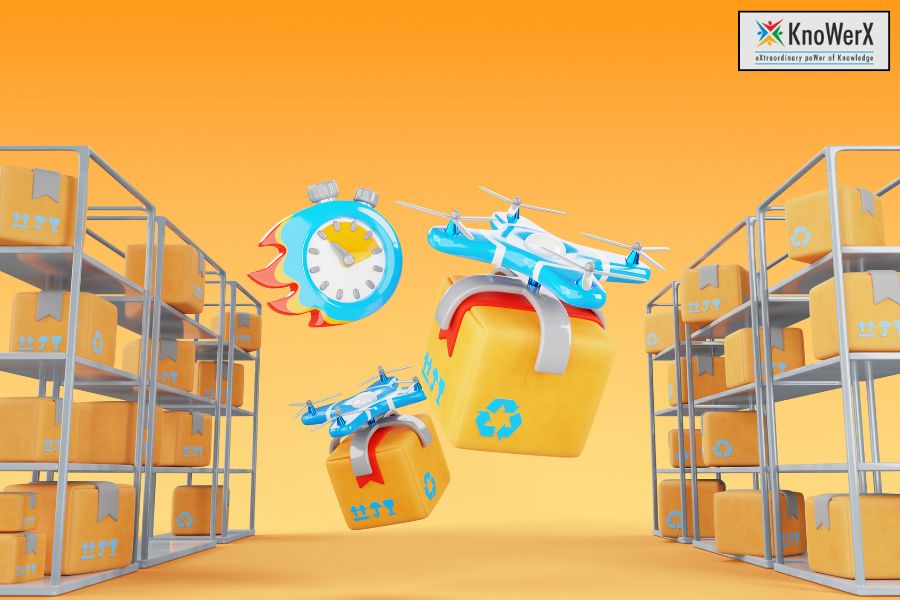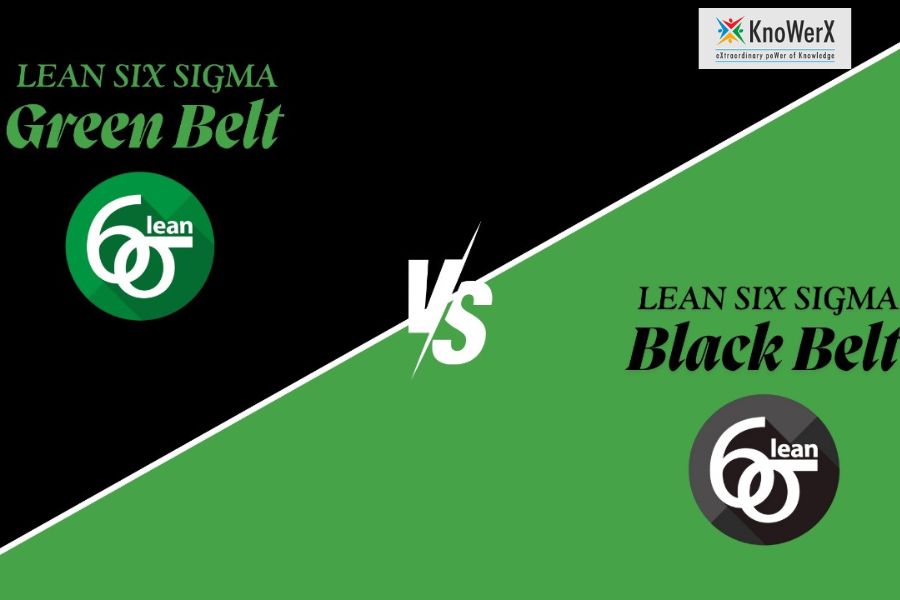Dominate Supply Chains With This Genius Logistics Framework

Dominate Supply Chains With This Genius Logistics Framework The global supply chain landscape is undergoing a radical transformation, driven by technological advancements and shifting market demands. At KnoWerX, with our 33+ years of industry expertise, we recognize that adopting the right Logistics Framework is no longer optional it’s the key differentiator between thriving businesses and those struggling to keep pace. This revolutionary approach integrates cutting-edge technologies, data-driven strategies, and sustainable practices to create agile, efficient, and future-ready supply chains. Whether you’re a logistics professional, supply chain manager, or business leader, understanding and implementing this Logistics Framework will position you at the forefront of industry innovation. Below, we break down the essential strategies that make this framework a game-changer. 1. Embrace Digital Integration A modern Logistics Framework thrives on digital tools like IoT, AI, and blockchain. Automating processes reduces errors and speeds up operations. By integrating real-time tracking and automated decision-making, businesses can respond faster to disruptions. Digital transformation also enhances visibility across the entire supply chain, making it easier to identify bottlenecks and optimize workflows. 2. Optimize Warehouse Management Implement smart warehousing solutions within your Logistics Framework to enhance inventory tracking, reduce waste, and improve order fulfillment. Advanced technologies like RFID and automated storage systems can drastically cut down manual labor and errors. A well-structured warehouse layout, combined with data-driven insights, ensures faster picking, packing, and shipping processes. 3. Strengthen Supplier Collaboration A robust Logistics Framework fosters real-time communication with suppliers, ensuring transparency and minimizing delays. Building strong partnerships with reliable vendors helps in negotiating better terms and securing priority during high-demand periods. Collaborative platforms and shared dashboards enable seamless coordination, reducing lead times and improving supply chain resilience. 4. Leverage Data Analytics Use predictive analytics within your Logistics Framework to forecast demand, optimize routes, and reduce costs. Historical data combined with machine learning can help anticipate market trends and adjust inventory levels accordingly. Real-time analytics also enable dynamic rerouting of shipments to avoid delays, ensuring on-time deliveries and higher customer satisfaction. 5. Focus on Sustainability & Green Logistics An advanced Logistics Framework should prioritize eco-friendly practices to meet modern regulatory and consumer demands. Implementing electric fleets, optimizing delivery routes for fuel efficiency, and using recyclable packaging can significantly reduce carbon footprints. Sustainable logistics not only benefits the environment but also enhances brand reputation and can lead to long-term cost savings through energy-efficient operations. 6. Enhance Last-Mile Delivery Solutions The last mile is often the most expensive and challenging part of logistics. A smart Logistics Framework incorporates innovative last-mile strategies like drone deliveries, micro-fulfillment centers, and crowdshipping to cut costs and improve speed. Leveraging AI-powered route optimization and real-time tracking ensures faster, more transparent deliveries, leading to higher customer satisfaction and repeat business. Frequently Asked Questions Ending Remarks At KnoWerX, we empower professionals with the knowledge and tools to master these innovations through our industry-leading Supply Chain Management Training programs. Whether you’re looking to upskill or transform your organization’s logistics approach, our expert-led courses provide the actionable insights you need to succeed. Ready to revolutionize your supply chain? Enroll with KnoWerX today and lead the change in the logistics evolution! Image Reference: Freepik Disclaimer: All trademarks, logos, and brand names are the property of their respective owners. All company, product, and service names used in this website are for identification purposes only. Use of these names, trademarks, and brands does not imply endorsement.
Check these Best Customer and Order Management Strategies

Check these Best Customer and Order Management Strategies Effective Customer and Order Management is crucial for optimizing supply chain efficiency, enhancing customer satisfaction, and driving business growth. As industry leaders in Supply Chain Management Training, KnoWerX brings you expert-backed strategies to refine your processes. 1. Leverage Technology for Real-Time Tracking Invest in advanced order management systems (OMS) and customer relationship management (CRM) tools to track orders in real time. Automation reduces errors, speeds up fulfillment, and enhances transparency—key factors in improving Customer and Order Management. Integrate AI-powered analytics to predict delays and optimize delivery routes. Cloud-based platforms ensure accessibility across departments, fostering seamless coordination. With KnoWerX’s training, professionals learn to maximize these tools for superior Customer and Order Management efficiency. 2. Streamline Order Processing Workflows Optimize workflows by eliminating redundant steps in order processing. A well-structured system ensures faster turnaround times, reducing delays and improving Customer and Order Management efficiency. Implement batch processing and automated approvals to minimize manual intervention. Standardized workflows reduce bottlenecks, ensuring consistent order fulfillment. KnoWerX’s supply chain courses teach best practices for designing agile workflows that enhance Customer and Order Management performance. 3. Enhance Communication with Customers Proactive communication keeps customers informed about order status, delays, or changes. Automated notifications via email or SMS improve trust and satisfaction a vital aspect of strong Customer and Order Management. Use chatbots and self-service portals to provide instant updates and resolve queries. Personalized follow-ups post-delivery strengthen relationships and encourage repeat business. KnoWerX’s training emphasizes communication strategies that elevate Customer and Order Management experiences. 4. Implement Data-Driven Decision Making Use analytics to identify trends in customer behavior, order patterns, and supply chain bottlenecks. Data insights help refine inventory planning and demand forecasting, strengthening Customer and Order Management strategies. Predictive analytics can anticipate demand spikes, ensuring optimal stock levels. Dashboards with real-time KPIs enable quick adjustments to order strategies. KnoWerX’s programs train professionals to harness data for smarter Customer and Order Management decisions. 5. Train Your Team on Best Practices A well-trained workforce is essential for seamless operations. KnoWerX’s Supply Chain Management Training programs equip professionals with the latest techniques to optimize Customer and Order Management processes. Regular workshops on CRM tools, conflict resolution, and process optimization keep teams updated. Cross-functional training ensures alignment between sales, logistics, and customer service. KnoWerX’s expertise helps businesses build high-performing teams for flawless Customer and Order Management. 6. Offer Flexible Order Fulfillment Options Provide multiple delivery options (same-day, next-day, or scheduled deliveries) to cater to diverse customer needs. Flexibility enhances satisfaction and retention key goals in Customer and Order Management. Partner with reliable logistics providers to expand delivery networks. Subscription-based models and bulk discounts can further attract loyal customers. KnoWerX’s training covers innovative fulfillment strategies to boost Customer and Order Management success. 7. Monitor and Improve Customer Feedback Loops Regularly collect and analyze customer feedback to identify pain points. Continuous improvement based on insights ensures long-term success in Customer and Order Management. Use surveys, reviews, and social media listening to gauge satisfaction. Act on feedback by refining return policies, delivery times, or product availability. KnoWerX teaches professionals to turn feedback into actionable Customer and Order Management enhancements. 8. Optimize Inventory Management Align inventory levels with demand forecasts to prevent stockouts or overstocking. Efficient inventory control is a cornerstone of effective Customer and Order Management. Adopt Just-in-Time (JIT) or ABC analysis to prioritize high-demand products. RFID and IoT-enabled tracking improve accuracy and reduce losses. KnoWerX’s supply chain training provides techniques to master inventory for seamless Customer and Order Management. Frequently Asked Questions Ending Notes At KnoWerX, we empower professionals with industry-leading Supply Chain Management Training to excel in Customer and Order Management. With over 33 years of collective expertise, our programs help you implement best practices and drive business success. Enroll today and transform your supply chain operations! Image Reference: Freepik Disclaimer: All trademarks, logos, and brand names are the property of their respective owners. All company, product, and service names used in this website are for identification purposes only. Use of these names, trademarks, and brands does not imply endorsement.
How Supply Chain Maturity Stages Impact Businesses

How Supply Chain Maturity Stages Impact Businesses In an increasingly competitive landscape, businesses must evolve their supply chain operations to stay ahead. Understanding the Supply Chain Maturity Stages enables organisations to optimise resources, reduce inefficiencies, and increase value delivery. At KnoWerX, we specialise in guiding professionals through these stages with structured training and industry-relevant certifications that make a measurable difference. 1. What Are the Supply Chain Maturity Stages? The Supply Chain Maturity Stages represent a roadmap to achieving full operational integration and strategic excellence. These stages range from reactive and siloed functions to collaborative, fully synchronised systems. By identifying your current stage, you can create a customised improvement plan to evolve your supply chain effectively and systematically. Stage 1 – Reactive: Unstructured and crisis-driven, lacking planning. Stage 2 – Functional: Basic planning within isolated departments. Stage 3 – Internal Integration: Coordinated efforts across functions. Stage 4 – External Integration: Collaboration with suppliers and customers. Stage 5 – Extended Enterprise: Fully optimised, end-to-end value chain management. 2. Why Businesses Should Understand Supply Chain Maturity Stages A clear grasp of the Supply Chain Maturity Stages helps businesses avoid stagnation and remain responsive to market dynamics. It enables leadership to make informed investments in people, processes, and technology. More importantly, it allows teams to adopt best practices progressively, without overwhelming the system. 3. Key Benefits of a Mature Supply Chain Progressing through the Supply Chain Maturity Stages allows companies to reduce excess costs, improve customer satisfaction, and respond quickly to disruptions. A mature supply chain supports sustainable growth and better aligns operations with business strategy. It also enhances supplier and customer collaboration, making the organisation more resilient. 4. KnoWerX Tip: Start with a Maturity Assessment Begin your journey through the Supply Chain Maturity Stages with a thorough maturity audit. Assessing current capabilities helps identify gaps in technology, skills, and integration. At KnoWerX, we offer expert-led assessments that provide actionable insights, helping your organisation take focused steps toward higher efficiency. 5. Key Performance Areas (KPAs) to Monitor Each stage in the Supply Chain Maturity Stages can be evaluated using well-defined KPAs such as forecasting accuracy, on-time delivery, inventory turnover, and supplier reliability. Consistently tracking these indicators helps measure your maturity level and prioritise areas for improvement. As performance improves, so does your competitive edge. 6. Invest in Training and Professional Development Moving up the Supply Chain Maturity Stages requires skilled professionals who understand both theory and application. KnoWerX’s training programs provide certifications aligned with global standards, ensuring your team is always a step ahead. Investing in learning translates directly into supply chain success and long-term ROI. 7. Encourage Cross-Functional Collaboration Transitioning from siloed functions to integrated planning is a critical milestone within the Supply Chain Maturity Stages. Teams must collaborate across departments like procurement, production, and logistics to align goals. A unified approach enables faster decision-making, resource sharing, and better conflict resolution. 8. Gradually Integrate Technology Technology acts as a bridge to move through the Supply Chain Maturity Stages, enhancing visibility and real-time control. Start with foundational systems like ERP and gradually adopt advanced tools like AI and predictive analytics. KnoWerX helps you choose the right tech for your current maturity level and future scalability. 9. Build Strong Supplier and Customer Relationships As companies move into the higher Supply Chain Maturity Stages, strong external partnerships become a strategic advantage. Transparent, data-driven collaboration with suppliers and customers leads to improved service levels, joint innovation, and reduced lead times. These relationships are built on trust and mutual growth. Frequently Asked Questions Ending Notes The journey through the Supply Chain Maturity Stages is more effective with the right guidance. KnoWerX, with 26+ years in consulting and professional education, offers hands-on expertise, customised training, and global certification programs. We equip professionals and organisations to achieve maturity and thrive in a rapidly changing world. Image Reference: Freepik Disclaimer: All trademarks, logos, and brand names are the property of their respective owners. All company, product, and service names used in this website are for identification purposes only. Use of these names, trademarks, and brands does not imply endorsement.
Six Sigma Basic Principles: What They Don’t Tell You!

Six Sigma Basic Principles: What They Don’t Tell You! At KnoWerX, we believe that understanding the Six Sigma Basic Principles goes beyond textbooks and buzzwords. With over 33 years of collective expertise and more than 26 years in education and consultancy, we have trained and empowered professionals across India and abroad. Our goal is simple equip you with knowledge that actually works in the real world. So, let’s break down the Six Sigma Basic Principles in a way that most training programs don’t. Here are essential tips to help you adopt the right mindset and methodology when approaching Six Sigma: Understand the True Meaning of “Define” Six Sigma Basic Principles start with the Define phase, but it’s not just about identifying a problem. It’s about defining the customer’s voice, setting clear objectives, and ensuring all stakeholders understand the value of solving that problem. Most failures happen because teams misunderstand what’s actually wrong or chase the wrong problem. A strong “Define” stage eliminates misdirection early. Measure What Truly Matters Measurement isn’t just about data collection. A core part of the Six Sigma Basic Principles is distinguishing between “nice-to-have” data and critical-to-quality (CTQ) metrics. Focus your efforts on what directly impacts the customer and process performance. Too much irrelevant data can cloud judgement measure only what aligns with your improvement goals. Analyse Without Bias While analysis is a key pillar of the Six Sigma Basic Principles, what they don’t often tell you is how bias can creep in. Use root cause analysis tools objectively, and avoid cherry-picking data to fit assumptions. Look deeper than surface-level causes. Bias in this phase can sabotage even the most well-intentioned project. Improve Through Small, Sustainable Changes The Improve phase isn’t about massive overhauls it’s about incremental, intelligent modifications. Focus on low-cost, high-impact solutions that are sustainable and scalable. Consistency over complexity is the secret. Don’t underestimate the power of small tweaks that add up over time. Control = Continuous Vigilance Control doesn’t mean you’re done. One of the Six Sigma Basic Principles often overlooked is that control is ongoing. Use control charts, KPIs, and audit systems to maintain and improve results over time. Sustainability is a mindset, not a milestone. Even the best improvements can backslide without proper control mechanisms. Culture Is Key Adopting the Six Sigma Basic Principles isn’t just about tools and methods it’s a cultural shift. Embed Six Sigma thinking across all departments and encourage collaboration, accountability, and continuous improvement from the ground up. Success thrives in organisations where every employee is part of the quality journey, not just the quality team. The Right Way to Approach Six Sigma Don’t just “learn” Six Sigma live it. Align your Six Sigma strategy with your company’s goals. Get certified with an institute that offers real-world application, not just theory. Invest in data literacy across teams. Choose a reliable training partner like KnoWerX, who blends deep industry experience with practical insight. Approaching Six Sigma the right way means integrating its principles into your everyday decision-making, not treating it as a one-time project. When teams are aligned with business goals and equipped with practical, data-driven tools, Six Sigma becomes a powerful engine for transformation. At KnoWerX, we focus on not just teaching Six Sigma but preparing professionals to apply it where it matters most in real business environments. Frequently Asked Questions Ending Notes Mastering the Six Sigma Basic Principles isn’t just about passing a certification it’s about transforming how you think, solve problems, and drive value within your organisation. The real secret lies in applying these principles with clarity, consistency, and commitment. At KnoWerX, we don’t just provide training we empower professionals to implement Six Sigma effectively in dynamic business environments. Image Reference: Freepik Disclaimer: All trademarks, logos, and brand names are the property of their respective owners. All company, product, and service names used in this website are for identification purposes only. Use of these names, trademarks, and brands does not imply endorsement.
Strengthening Value Proposition and Value Chains

Strengthening Value Proposition and Value Chains Let’s talk about something that can really make your business stand out: a compelling value proposition. It’s like your secret sauce it sets you apart from the crowd and shows your customers exactly why you’re the perfect fit for them. The trick is to zero in on what’s bugging them (their pain points) and then spell out how your solution makes their lives better. Simple, right? A solid Value Proposition and Value Chains strategy is like a trusty compass for your whole team. It’s not just a fancy statement it guides decisions everywhere, from the warehouse to the boardroom. When everyone’s on the same page, magic happens. Know Your Customer Inside Out Your value proposition starts with your people the ones you’re serving. Get curious: What keeps them up at night? What do they dream about solving? Chat with them, listen hard, and dig into what they really need. When your Value Proposition and Value Chains reflect their world, you’re not just selling you’re solving. And that’s when they stick around. Craft a Clear, Bold Promise Don’t beat around the bush. Tell your customers exactly what you’re bringing to the table and why it’s a game-changer. Skip the jargon and make it real: “We’ll save you time,” or “We’ll cut your stress in half.” A strong, simple promise ties your Value Proposition and Value Chains together it’s the heartbeat of why you exist. Align Internal Processes with Value Creation Picture this: every step, from ordering supplies to dropping off the final product, works together like a well-oiled machine. No more departmental standoffs or “that’s not my job” vibes. When teams break down walls and chase goals that actually matter to your customers, you’re not just making their day you’re saving some cash along the way too. It’s a win-win! Optimise Supply Chain Activities Let’s get practical. A smooth supply chain is your ticket to staying ahead. Think smart forecasting, cutting down on stuff sitting around gathering dust, and maybe even letting robots handle the boring bits. At KnoWerX, we’ve seen firsthand how our supply chain training helps folks like you turn data into decisions that make everything run better. It’s pretty cool to watch! Build Resilience in Value Chains Life’s unpredictable supply chains aren’t immune. But you can be ready. Stock up a little extra, build strong ties with your suppliers, and don’t put all your eggs in one basket. When your Value Proposition and Value Chains can roll with the punches, your customers feel the difference. They’ll trust you to deliver, rain or shine. Measure and Adapt Continuously Keep your finger on the pulse. Are your customers happy? Are orders flying out the door on time? What’s the bottom line looking like? Dig into the numbers and tweak things as you go. With a little data love, your Value Proposition and Value Chains stay nimble ready to jump on opportunities or dodge curveballs. Ending Notes At KnoWerX, we’re all about helping you build something that lasts. With 26+ years of training and consulting under our belt, we’re here to arm you with the know-how and tools to shine. Whether you want to level up your value game, streamline your supply chain, or future-proof your operations, we’ve got your back. Our expert-led programs and real-world strategies ensure you stay ahead in a fast-changing market. Let’s turn challenges into opportunities and make your business unstoppable Image Reference: Freepik Disclaimer: All trademarks, logos, and brand names are the property of their respective owners. All company, product, and service names used in this website are for identification purposes only. Use of these names, trademarks, and brands does not imply endorsement.
Operational Strategies in SCM: The Hidden Risks You Can’t Ignore

Operational Strategies in SCM: The Hidden Risks You Can’t Ignore In the ever-evolving world of Supply Chain Management (SCM), businesses rely on operational strategies to optimise efficiency and drive growth. However, hidden risks in these strategies can lead to significant disruptions. Identifying and mitigating these risks is crucial for long-term success. Here are key insights into operational strategies in SCM, their goals, key aspects, and potential risks you must address. Over-Reliance on a Single Supplier A common risk in operational strategies is depending too much on one supplier. If the supplier faces production issues or financial troubles, your entire supply chain could suffer. Tip: Diversify your supplier base to reduce dependency and ensure continuity. Implement dual sourcing strategies and maintain a buffer stock for essential raw materials. Poor Demand Forecasting Inaccurate demand predictions can lead to excessive inventory or shortages, impacting profitability. Seasonal fluctuations and market uncertainties can further complicate forecasting. Tip: Use AI-powered forecasting tools to improve accuracy and adjust strategies dynamically. Incorporate real-time sales data and customer insights to refine predictions. Lack of Supply Chain Visibility Limited visibility into supply chain operations can lead to inefficiencies and delayed decision-making. Without real-time insights, businesses struggle to identify bottlenecks and optimise workflows. Tip: Invest in real-time tracking systems and analytics to monitor the entire supply chain. Implement supply chain control towers for a comprehensive overview of logistics and inventory. Inefficient Inventory Management Excess inventory increases holding costs, while inadequate stock leads to missed sales opportunities. Overstocking ties up capital, while understocking impacts service levels. Tip: Implement Just-In-Time (JIT) inventory techniques to balance stock levels effectively. Use automated replenishment systems and demand-driven inventory planning. Logistics Disruptions Unforeseen transportation issues, such as fuel price fluctuations or natural disasters, can disrupt supply chains. Poor route planning and inefficient freight management can also add to delays. Tip: Develop contingency plans and work with multiple logistics providers to enhance flexibility. Use AI-powered route optimisation tools to improve delivery efficiency. Cybersecurity Threats Supply chains are vulnerable to cyberattacks that can compromise sensitive data. Ransomware, phishing, and data breaches can halt operations and result in financial losses. Tip: Strengthen cybersecurity measures, conduct regular audits, and train employees on best practices. Implement multi-factor authentication and encrypted communication channels. Resistance to Technology Adoption Failure to adopt modern technologies can slow down operations and make businesses less competitive. Legacy systems may hinder collaboration and limit real-time data access. Tip: Encourage a culture of innovation and provide training for employees to adopt new systems seamlessly. Offer hands-on workshops and incentivise digital transformation initiatives. Examples of Operational Strategies in SCM Lean Manufacturing: A lean inventory management approach reduces waste and optimises efficiency. By focusing on continuous improvement, businesses can minimise production delays and enhance product quality. AI-Driven Logistics Networks: Companies leverage automated warehouses and AI-driven logistics for rapid order fulfilment. An extensive distribution network ensures efficient deliveries across various regions. Supplier Collaboration Models: Some businesses maintain strategic partnerships with suppliers to improve supply chain transparency and efficiency. Vendor Managed Inventory (VMI) systems enable real-time stock replenishment and better demand forecasting. Fast Fashion Supply Chains: Certain retailers focus on short lead times and efficient inventory management to respond quickly to market trends. An agile supply chain allows rapid product design and store distribution. Frequently Asked Questions Ending Notes Developing strong operational strategies in SCM is essential for business success, but recognising hidden risks is just as crucial. By addressing potential threats proactively, companies can build resilient and agile supply chains. At KnoWerX, we provide industry-leading training and certifications to help professionals master the complexities of supply chain management. Stay ahead of the competition by enhancing your operational strategies with KnoWerX – your trusted partner in SCM training and professional growth! Image Reference: Freepik Disclaimer: All trademarks, logos, and brand names are the property of their respective owners. All company, product, and service names used in this website are for identification purposes only. Use of these names, trademarks, and brands does not imply endorsement.
Top Supply Chain Strategies to Skyrocket Your Profits

Top Supply Chain Strategies to Skyrocket Your Profits In today’s competitive business landscape, effective supply chain strategies are the backbone of profitability and operational success. Whether you’re a seasoned professional or just starting your journey in supply chain management, implementing the right strategies can transform your business outcomes. At KnoWerX, we bring over 32 years of collective experience in training and consultancy to help you master these strategies and achieve excellence. Here are some actionable tips and key elements to build a successful supply chain strategy that will skyrocket your profits: 1. Leverage Technology for Visibility Invest in advanced tools like AI, IoT, and blockchain to gain real-time visibility into your supply chain. This helps in tracking inventory, predicting demand, and mitigating risks effectively. By integrating technology, you can automate repetitive tasks, reduce human error, and improve decision-making. A tech-driven supply chain also enables better collaboration with partners and stakeholders, ensuring smoother operations. 2. Optimize Inventory Management Striking the right balance between overstocking and stockouts is crucial. Use data analytics to forecast demand accurately and maintain optimal inventory levels. Implementing just-in-time (JIT) inventory practices can reduce holding costs and minimize waste. Additionally, regular audits and inventory tracking systems can help identify slow-moving items and prevent dead stock, ensuring better cash flow and profitability. 3. Build Strong Supplier Relationships Collaborate closely with your suppliers to ensure timely deliveries, negotiate better terms, and foster long-term partnerships. Strong supplier relationships can lead to cost savings, improved quality, and access to innovative solutions. Regularly evaluate supplier performance and maintain open communication to address issues proactively. A reliable supplier network is a cornerstone of a resilient supply chain. 4. Focus on Cost Efficiency Identify areas where you can reduce costs without compromising quality. This could include streamlining transportation, consolidating shipments, or adopting lean practices. Conduct regular cost-benefit analyses to identify inefficiencies and explore alternative solutions. By optimizing logistics and reducing waste, you can significantly improve your bottom line while maintaining high service levels. 5. Enhance Customer-Centricity Align your supply chain strategies with customer expectations. Faster delivery times, personalized services, and seamless returns can significantly boost customer satisfaction and loyalty. Use customer feedback to refine your processes and ensure your supply chain is agile enough to meet changing demands. A customer-centric approach not only drives repeat business but also enhances your brand reputation. 6. Adopt Sustainable Practices Sustainability is no longer optional. Implement eco-friendly practices like reducing waste, using renewable energy, and sourcing ethically to meet regulatory requirements and consumer demands. Sustainable supply chain strategies can also lead to cost savings in the long run, as they often involve optimizing resource usage. Additionally, showcasing your commitment to sustainability can attract environmentally conscious customers and investors. Why Choose KnoWerX for Mastering Supply Chain Strategies? At KnoWerX, we are committed to empowering professionals with the knowledge and skills needed to excel in supply chain management. With over 25 years of experience in education and consultancy, we have trained and consulted for large companies across India and abroad. Our professional training programs are designed to help you: Learn the best practices in supply chain management. Acquire domain-specific knowledge and certifications. Implement effective supply chain strategies to drive profitability. We offer high-quality education at the best price in the industry, making us your one-stop destination for professional growth. Frequently Asked Questions Ending Notes Mastering the right supply chain strategies is the key to unlocking higher profits and achieving operational excellence. By leveraging technology, optimizing processes, and focusing on continuous improvement, you can build a resilient and efficient supply chain. Let KnoWerX be your partner in this journey. Explore our training programs today and take the first step toward transforming your supply chain and skyrocketing your profits! Image Reference: Freepik Disclaimer: All trademarks, logos, and brand names are the property of their respective owners. All company, product, and service names used in this website are for identification purposes only. Use of these names, trademarks, and brands does not imply endorsement.
Six Sigma Green Belt vs Black Belt: Who Really Wins?

Six Sigma Green Belt vs Black Belt: Who Really Wins? In today’s competitive business landscape, achieving operational efficiency and process improvement is vital for organisations. Six Sigma, a widely recognised methodology, helps professionals enhance business performance through data-driven decision-making. But when it comes to choosing between a Six Sigma Green Belt vs Black Belt, which certification is the right fit? Understanding the key differences, career benefits, and training requirements can help professionals make an informed decision. 1. Assess Your Career Goals If you are new to Six Sigma or want to support projects while working in your current role, a Green Belt is an excellent choice. It allows you to build foundational knowledge and contribute effectively to process improvements. If you aspire to lead complex projects, mentor Green Belts, and drive high-level strategic improvements, a Black Belt is ideal. This certification positions you as a key leader in process optimisation and efficiency. 2. Evaluate Your Level of Expertise Green Belts work on process improvement as part of their role but do not usually lead large-scale projects. They assist Black Belts in implementing Six Sigma methodologies within their organisation. Black Belts are full-time problem solvers who drive change and train others in Six Sigma methodologies. They have advanced statistical skills and take ownership of large-scale process transformations. 3. Consider Training and Certification Requirements Green Belt training typically requires fewer training hours and covers basic Six Sigma tools. It is suitable for professionals looking to integrate Six Sigma principles into their existing job roles. Black Belt training is more intensive and includes leadership training, statistical analysis, and project management. It requires a deep understanding of Six Sigma methodologies and the ability to manage high-impact projects. 4. Understand the Expected Salary and Job Opportunities Professionals with Black Belt certification often earn higher salaries and have leadership roles. Their expertise in data-driven decision-making makes them valuable assets to organisations. Green Belts can advance their careers by gaining hands-on experience and moving toward a Black Belt in the future. They can also apply their knowledge to improve workflow efficiency and problem-solving capabilities. 5. Determine Your Level of Responsibility A Green Belt primarily supports projects and focuses on improving specific processes within a team. They work closely with Black Belts and other team members to enhance operational efficiency. A Black Belt leads projects, manages cross-functional teams, and plays a critical role in overall business strategy. They are responsible for driving major changes that impact company-wide performance. 6. Choose the Right Training Partner Regardless of your choice between Six Sigma Green Belt vs Black Belt, selecting the right training provider is crucial. A reputable provider ensures you gain the necessary skills and industry recognition. KnoWerX offers world-class training with expert instructors, real-world case studies, and industry-recognised certification to help you excel. Our courses are designed to provide practical knowledge that enhances career growth. Frequently Asked Questions Ending Notes There is no clear winner in the debate of Six Sigma Green Belt vs Black Belt—the right choice depends on your career aspirations. If you are looking for foundational knowledge and supporting roles, the Green Belt is ideal. If you want to lead, train, and drive organisational change, the Black Belt is the better choice. Both certifications offer excellent career benefits and opportunities for growth. Advance Your Career with KnoWerX! At KnoWerX, we help professionals achieve excellence through our industry-leading Six Sigma training programs. Whether you choose a Green Belt or a Black Belt, our expert training will equip you with the skills needed to thrive in today’s competitive job market. Our certifications are widely recognised and highly valued by top organisations worldwide. Image Reference: Freepik Disclaimer: All trademarks, logos, and brand names are the property of their respective owners. All company, product, and service names used in this website are for identification purposes only. Use of these names, trademarks, and brands does not imply endorsement.
Women in Supply Chain Management in India

Women in Supply Chain Management in India Diversity and gender equality in the workplace has been a topic of discussion for several decades around the globe and even in India. Same is the case with the discussion topic “women in supply chain management”. I will start the discussion starting from B-Schools. In B-Schools, more students prefer to take finance and marketing as their specialization rather than operations or supply chain management. Major reason being the earning difference, but somehow operations and supply chain management also get an impression of interacting with workers and truck drivers, that is completely wrong. Digitization and Data Science in Supply Chain Transformation Today’s supply chain management professionals do planning and control of demand, operations, materials, procurement, capacity, distribution, logistics, transportation, etc. and design/transform supply chain management strategy, network, resources, etc. Supply chain managers are increasingly getting involved in digitizing every aspect of supply chain management and transforming supply chain by getting deeper insights using data science. I remember, when I was a student in my engineering college, there were less than 1% girl students. That time, engineering was not considered as an appropriate profession for women. With increasing opportunities available in information technology field, more girls take up engineering as information technology jobs do not require physical hard work and working in harsh environment. Similarly, girl students have also increased in B-Schools. But, the proportion of students taking up operations/supply chain management as specialization has not increased much. Women Representation in Supply Chain Workforce In “2024 Women in Supply Chain Survey” done by Gartner-AWESOME, supply chain management workforce found to have 40% women. However, less women are found in leadership roles, like CSCO – Chief Supply Chain Officer. Reports from ASCM (Association for Supply Chain Management, formerly APICS) indicate that while the supply chain field has historically been male dominated, there’s a growing trend of more women entering the profession. Surveys from ASCM provide data on the gender distribution of supply chain management professionals, which gives an indirect indication of certification trends. For example, some surveys show that around 39 percent of respondents were women. It is important to understand that the percentage of women in the general supply chain workforce, and the percentage of women holding certifications may vary. Ending Remarks Our database at KnoWerX Education also shows that less than 10% women get APICS certified. Usually, women’s earnings are additional income to run the household and family. There is also a gap between pay scale of men and women. Women have a greater focus on family rather than on the career. In one of the APICS Conferences, I was talking to an American woman consultant in the field of supply chain management working for one of the top consulting firms in the US. She shared her career journey and told me that she refused promotion as it required relocation. She did not want to be away from family, especially her children. However, in my opinion, in the future to come, more women will choose supply chain management as their profession and more women will get certified to accelerate their growth in their career in India. — Ravindra K. Tulsyan, MTech DBF CFPIM CIRM CSCP SCOR-P PLS CLTD DDPP DDLP CTSC Image Reference: Freepik Disclaimer: All trademarks, logos, and brand names are the property of their respective owners. All company, product, and service names used in this website are for identification purposes only. Use of these names, trademarks, and brands does not imply endorsement.
The Shocking Truth About Demand Forecasting Errors

The Shocking Truth About Demand Forecasting Errors Demand forecasting is a critical component of supply chain management that helps businesses predict future customer demand for their products or services. By analyzing historical data, market trends, and other relevant factors, companies can make informed decisions about production, inventory, and resource allocation. However, despite its importance, demand forecasting is not foolproof. Errors in forecasting can lead to overstocking, stockouts, lost sales, and ultimately, a significant impact on a company’s bottom line. What is Demand Forecasting? Demand forecasting is the process of estimating future customer demand using historical data, market analysis, and statistical models. It helps businesses plan their operations, optimize inventory levels, and align their supply chain strategies with market needs. Accurate demand forecasting ensures that companies can meet customer expectations while minimizing costs and waste. It is a blend of art and science, requiring both analytical skills and an understanding of market dynamics. The Shocking Truth About Demand Forecasting Errors Even Small Errors Can Have Big Consequences: A minor miscalculation in demand forecasting can lead to overproduction, excess inventory, or stockouts. These errors can result in increased storage costs, lost sales, and dissatisfied customers. Over time, these small mistakes can accumulate, leading to significant financial losses and reputational damage. Over-Reliance on Historical Data: While historical data is essential, relying solely on it can be misleading. Market trends, consumer behavior, and external factors like economic shifts or pandemics can disrupt demand patterns. Businesses must incorporate real-time data and predictive analytics to stay ahead of changing market conditions. Lack of Collaboration Between Teams: Siloed departments often lead to inaccurate forecasts. For example, if the sales team doesn’t share insights with the supply chain team, the forecast may not reflect real-time market conditions. Cross-functional collaboration is crucial for creating a holistic and accurate demand forecast. Ignoring External Factors: Events like natural disasters, geopolitical issues, or competitor actions can significantly impact demand. Failing to account for these factors can render forecasts useless. Businesses must adopt a proactive approach by monitoring external environments and incorporating risk management into their forecasting processes. Inadequate Tools and Expertise: Many businesses still rely on outdated tools or lack the expertise to implement advanced forecasting techniques, leading to suboptimal results. Investing in modern forecasting software and upskilling employees can significantly improve accuracy and efficiency. Key Benefits of Effective Demand Forecasting Improved Inventory Management: Accurate forecasts help businesses maintain optimal inventory levels, reducing carrying costs and minimizing stockouts. This ensures that products are available when customers need them, without tying up capital in excess inventory. Enhanced Customer Satisfaction: Meeting customer demand promptly and efficiently leads to higher satisfaction and loyalty. Accurate forecasting ensures that businesses can deliver the right products at the right time, creating a seamless customer experience. Cost Savings: By aligning production and procurement with actual demand, businesses can reduce waste and operational costs. Effective forecasting helps avoid overproduction, underproduction, and unnecessary expenses, improving overall profitability. Better Decision-Making: Reliable forecasts provide a solid foundation for strategic planning, helping businesses allocate resources effectively. From budgeting to workforce planning, accurate demand forecasting enables smarter, data-driven decisions. Competitive Advantage: Companies with accurate demand forecasting can respond quickly to market changes, outperforming competitors. By anticipating trends and customer needs, businesses can stay ahead of the curve and capture market opportunities. Master Demand Forecasting with KnoWerX PGP CFDM Certification If you’re looking to master the art and science of demand forecasting, KnoWerX’s Post Graduate Program in Certified Forecasting & Demand Management (PGP CFDM) is the perfect choice. This certification program is designed to equip professionals with the skills and knowledge needed to excel in demand forecasting and supply chain management. Why Choose KnoWerX PGP CFDM? Comprehensive Curriculum: Learn advanced forecasting techniques, demand planning strategies, and the latest tools and technologies. The program covers everything from basic concepts to advanced analytics, ensuring a well-rounded understanding. Industry-Relevant Skills: Gain hands-on experience with real-world case studies and projects. The program is designed to bridge the gap between theory and practice, preparing you for real-world challenges. Expert Faculty: Learn from industry veterans and academic experts with decades of experience. Their insights and guidance will help you navigate the complexities of demand forecasting with confidence. Global Recognition: Earn a certification that is respected by employers worldwide. The KnoWerX PGP CFDM certification is a mark of excellence in the field of supply chain management. Career Advancement: Enhance your career prospects in supply chain management, logistics, and operations. The program opens doors to high-demand roles and leadership positions in top organizations. Whether you’re a supply chain professional, a business owner, or an aspiring demand planner, the KnoWerX PGP CFDM certification will give you the edge you need to succeed in today’s competitive market. Frequently Asked Questions Ending Remarks At KnoWerX – An Institution of Supply Chain Management, we believe in empowering professionals with the expertise to tackle complex supply chain challenges. Our PGP CFDM certification is more than just a program; it’s a gateway to mastering demand forecasting and unlocking new opportunities in your career. Don’t let forecasting errors hold your business back. Enroll in KnoWerX’s PGP CFDM certification today and take the first step toward becoming a demand forecasting expert. Visit KnoWerX’s website to learn more and secure your spot! Image Reference: Freepik Disclaimer: All trademarks, logos, and brand names are the property of their respective owners. All company, product, and service names used in this website are for identification purposes only. Use of these names, trademarks, and brands does not imply endorsement.
